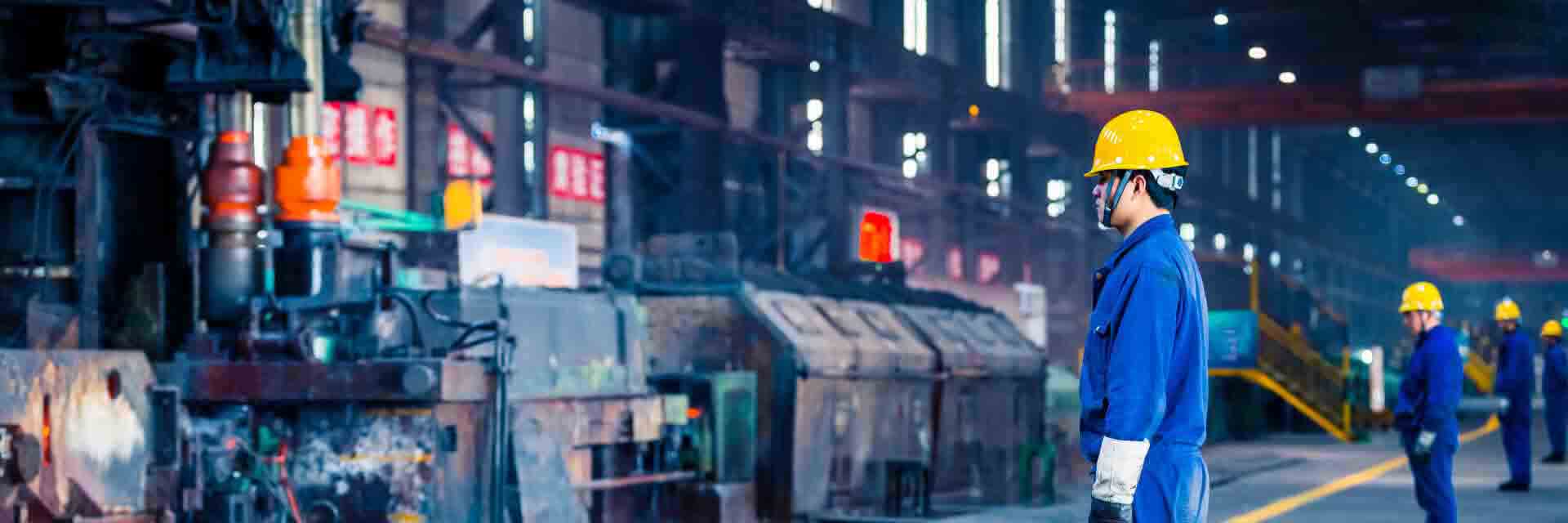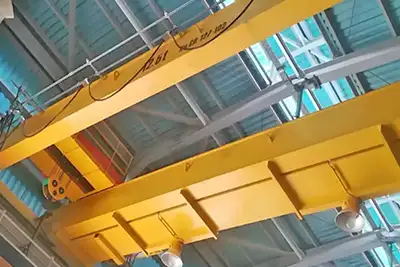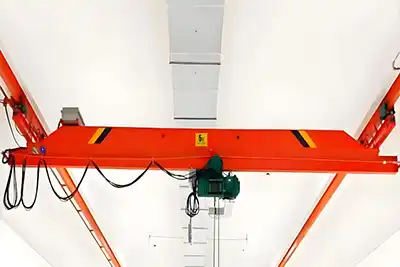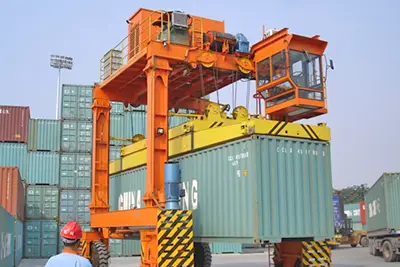Technical Guide: QB Explosion-Proof Double Girder Overhead Cranes
Introduction to QB Explosion-Proof Overhead Cranes
The QB series overhead cranes are built tough. They are heavy-duty cranes made especially for hazardous environments where safety is the top priority. These cranes are designed to work reliably even in places where there is a risk of explosions.
Where Are QB Cranes Used?
These cranes are commonly used in areas with flammable gases, vapors, or dust that can easily catch fire or explode. Think of places like chemical plants, oil refineries, and paint factories. They handle materials safely without creating sparks or heat that could trigger an accident.
Why Choose QB Explosion-Proof Cranes?
- Strong and reliable: The cranes can carry heavy loads and work in tough conditions.
- Safety first: Every part is made to reduce any chance of ignition.
- Certified and trusted: They meet international explosion-proof standards like Exd IIBT4 and Exd IICT4.
- Peace of mind: You get equipment that’s tested to keep your workers and facility safe.
In short, the QB cranes are a solid choice when you need heavy lifting and explosion protection all in one package.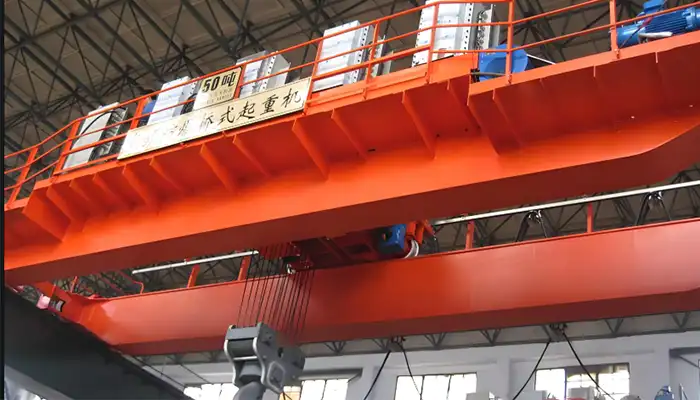
Explosion proof overhead crane QB Series for Sale 5 Ton to 75 Ton
Technical Specifications Overview
The QB series explosion-proof double girder overhead cranes are designed for tough industrial environments where safety and reliability are non-negotiable. These cranes handle heavy loads in hazardous areas with flammable gases, vapors, or dust. Built to meet strict international explosion-proof standards, they ensure smooth and secure operation no matter the conditions. With flexible specifications in lifting capacity, span, and height, the QB cranes can be tailored to fit your specific needs and keep your operations running safely and efficiently.
The QB explosion-proof cranes are built tough and designed to fit a wide variety of industrial needs. Here’s what you need to know:
- Lifting Capacity: From 5 to 75 tons — covers everything from lighter loads to heavy-duty tasks.
- Span Range: Between 10.5 meters and 31.5 meters — adjustable depending on your workspace size.
- Lifting Height: Options from 6 meters up to 18 meters — so you can reach exactly where you need.
- Working Duty Class: Rated A3 to A5, with A5 as the max — perfect for consistent, everyday use without risk of overworking.
- Ambient Temperature: Operates well from -20°C to 60°C — built to handle cold winters and hot summers.
In short, these specs mean the QB crane can be customized to fit your facility’s size, workload, and environment. Whether you need light lifting or heavy-duty performance, this crane series has you covered.
Crane Performance Parameters
Lifting Capacity and Speed
The QB cranes come in a range of lifting capacities from 5 tons up to 75 tons. As the capacity increases, the lifting speed generally decreases. This is to ensure safe and stable handling of heavier loads.
- Smaller capacity cranes (5 to 10 tons) can lift at about 5 meters per minute.
- For medium loads, like the 20 to 32-ton models, lifting speeds range between 4.1 to 4.2 meters per minute.
- The larger cranes (50 to 75 tons) lift more slowly, between 1.9 and 3 meters per minute, which helps maintain control and safety.
Traveling Speeds: Trolley and Crane Movement
Speed isn’t just about lifting — the crane and trolley travel speeds are also important for efficiency.
- The trolley speed (movement of the hoist along the girder) ranges from around 10.5 meters per minute for the largest cranes to about 20.5 meters per minute for smaller to medium models.
- The crane travel speed (movement of the entire crane on the runway) is a bit faster, reaching up to 22.3 meters per minute for smaller cranes, and slowing to about 15.4 meters per minute for the biggest cranes.
These speeds ensure smooth, precise positioning of loads while keeping within safe operating limits.
| Capacity (t) | Lifting Speed (m/min) | Trolley Speed (m/min) | Crane Speed (m/min) |
|---|---|---|---|
| 5 | 5.0 | 19.6 | 22.3 |
| 10 | 5.0 | 20.5 | 22.3 |
| 20 | 4.2 | 20.5 | 19.0 |
| 32 | 4.1 | 20.0 | 17.0 |
| 50 | 3.0 | 19.1 | 19.4 |
| 75 | 1.9 | 10.5 | 15.4 |
Track types vary by capacity: P43, QU70, QU80, QU100
Track Types by Capacity
The type of rail track used for the crane varies depending on its lifting capacity:
- For lighter cranes, P43 rail type is commonly used.
- Medium-capacity cranes often run on QU70 or QU80 rails.
- The heaviest models require stronger tracks like QU100 or specially sized rails such as 90×90 or 100×100 mm to support the load safely.
Duty Class and Speed Limits
When selecting a QB explosion-proof overhead crane, it’s important to understand the limits set for its usage. These limits help ensure the crane operates safely and reliably over time, especially in hazardous environments.
Duty Class
- The duty class describes how often and intensely the crane will be used.
- For QB cranes, the duty class must not exceed A5.
- This means the crane is designed for intermediate service — it can handle regular, but not continuous, heavy lifting tasks without wear or damage.
- Staying within this duty class protects the crane from overheating and mechanical stress, which is critical in explosive environments.
Speed Limits
Speed affects both safety and precision. The QB crane has clear limits on travel and hoisting speeds:
- Traveling speed for the crane and trolley:
The maximum allowed speed is 25 meters per minute.
This speed ensures the crane moves quickly enough to be efficient but not so fast that it risks losing control or causing accidents. - Hoisting speed:
The lifting speed must not exceed 8 meters per minute.
This slower speed is essential to keep loads stable and secure, preventing sudden movements that could spark or trigger an explosion.
Why These Limits Matter
- Keeping within the A5 duty class and speed limits helps maintain the crane’s durability and safety.
- It minimizes the risk of equipment failure and accidents in sensitive industrial areas.
- These limits also help comply with international explosion-proof standards, making the crane suitable for use in hazardous zones.
Power Supply and Wiring Requirements
Power supply and wiring are critical parts of the QB explosion-proof crane’s safety and performance. Proper design prevents electrical hazards and ensures smooth operation.
Flexible Cables for Movement
- The crane and trolley must use flexible cables for their power supply.
- Flexible cables allow the crane and trolley to move freely without stressing or damaging the wires.
- This flexibility helps avoid cable breakage and power interruptions during operation.
Grounding for Safety
- The main power cable must include a grounding core wire.
- Grounding is essential to protect people and equipment from electric shocks and short circuits.
- It provides a safe path for electrical faults, reducing the risk of sparks or fire in explosive environments.
No Cable Joints Allowed
- Cable joints or splices are not allowed in the middle of the power supply cables.
- Joints can create weak points where sparks or overheating might occur.
- Eliminating joints ensures continuous, reliable power flow and maintains explosion-proof integrity.
Explosion-Proof Electrical Equipment Design
Electrical parts of the QB crane must be designed carefully to avoid any risk of ignition in hazardous environments. This means controlling heat, dust, and sparks.
Temperature Control of Enclosures
- The surface temperature of all electrical enclosures must be kept below a safe limit.
- This prevents the enclosure from getting hot enough to ignite gases, vapors, or dust around the crane.
Dust Protection
- Enclosures should be dust-tight or at least dust-resistant.
- This stops combustible dust from entering and causing fires or explosions.
Electrical Isolation
- Each terminal hole is designed to carry only one wire.
- Every wire is individually sealed in its hole to stop sparks from jumping between wires.
- This isolation is key to preventing electrical arcs that could trigger explosions.
Distribution Box Layout
- Cable entry must be at the top, and cable exit at the bottom of the box.
- The main circuit wiring is arranged on the left side, while the control circuit wiring is on the right side.
- All internal wiring should be neatly aligned, both horizontally and vertically, making maintenance safer and easier.
Clear Labels for Safety
- All electrical enclosures need clear, permanent graphic and text labels.
- Labels help identify circuits quickly and reduce human error during inspections or repairs.
This strict design ensures the crane’s electrical system is safe and reliable in explosive environments. It helps prevent accidents and keeps your workplace secure.
Braking System Requirements
The braking system on the QB crane’s hoisting mechanism plays a crucial role in safety and reliability.
Dual Support Brakes
- The hoisting mechanism must have two independent support brakes.
- This redundancy means if one brake fails, the other can still hold the load safely.
- It ensures smooth and secure operation, especially when lifting heavy materials.
Explosion-Proof Brakes
- Both brakes need to be explosion-proof.
- They must meet strict explosion-proof standards designed for hazardous environments.
- This prevents sparks or heat from the brakes that could ignite flammable gases or dust around the crane.
In short, these braking requirements keep the crane safe and reliable while protecting the workplace from potential explosion risks.
Key Components and Their Functions
The QB explosion-proof crane is made up of several important parts that work together to ensure safe, reliable, and efficient operation in hazardous areas. Each component is designed with safety and durability in mind, meeting strict standards for use in explosive environments.
Crane Bridge
- Built as a strong double girder structure.
- Designed to carry heavy loads safely without bending or shaking.
- Provides a stable frame for smooth crane operation.
Hoisting Mechanism
- Features an explosion-proof winch to lift and lower loads.
- Equipped with dual braking systems for extra safety and control.
- Built to work reliably in hazardous environments without risk of sparks.
Travel Mechanism
- Ensures smooth movement of both the trolley (which carries the load) and the crane itself.
- Designed to operate safely in zones where flammable gases or dust may be present.
- Offers precise positioning for safer handling of heavy materials.
Electrical Equipment
- All electrical parts are enclosed in flameproof housings to prevent ignition sources.
- Proper grounding is included to protect against electrical faults and shocks.
- Designed to meet strict explosion-proof standards for safety.
Control System
- Comes with intelligent controls for easy and precise operation.
- Enhances safety by preventing unsafe movements.
- Designed to make the operator’s job easier and reduce errors.
Explosion-Proof Design Principles
Safety is the top priority in designing QB explosion-proof cranes. The goal is to completely eliminate any risk of sparks or heat that could ignite flammable gases, vapors, or dust in hazardous environments. This is done through careful material choices, strict temperature controls, and specialized enclosures.
- Prevent ignition sources
The crane is designed to avoid any arcs, sparks, or hot surfaces that could cause an explosion. Electrical components are sealed and insulated, and moving parts are engineered to minimize friction and avoid sparks. - Use non-sparking materials
Parts made from metals are selected to reduce spark risks. For example, magnesium and titanium, which can easily ignite or spark, are carefully controlled or avoided in alloy compositions. This helps keep mechanical parts safe during normal operation. - Dust-tight and flameproof enclosures
Electrical and mechanical parts are housed in enclosures that keep dust and gases out. These enclosures are sealed tight to prevent dust particles from entering, and they are built to withstand and contain any internal sparks or flames, ensuring nothing can escape to ignite the surrounding atmosphere.
By combining these design principles, the QB crane ensures reliable and safe operation in tough, explosive environments.
Safety Measures and Usage Recommendations
Using an explosion-proof crane safely requires more than just good design. Proper training, routine checks, and careful handling all play vital roles in preventing accidents and keeping the workplace secure. Here are key safety practices to follow:
- Train operators and maintenance staff thoroughly
Everyone who works with or around the crane should understand how explosion-proof equipment works. Training should cover safe operation, recognizing warning signs, and emergency procedures. Well-informed staff can prevent many accidents before they happen. - Schedule regular inspections and preventive maintenance
Consistent checks help spot wear, loose parts, or electrical issues early. Preventive maintenance keeps brakes, wiring, and controls in top condition, reducing the risk of failure in hazardous environments. - Use appropriate personal protective equipment (PPE)
Workers should wear gear suited for explosive environments, like flame-resistant clothing, safety helmets, gloves, and eye protection. PPE acts as a last line of defense against unexpected hazards. - Ensure proper electrical grounding and ventilation
Correct grounding prevents electrical faults that could spark fires. Good ventilation helps disperse any flammable gases or dust, reducing the chance of dangerous buildup around the crane. - Handle and store flammable materials safely
Keep flammable liquids, gases, and dust away from crane operation areas whenever possible. Proper storage reduces the risk of accidental ignition and improves overall safety.
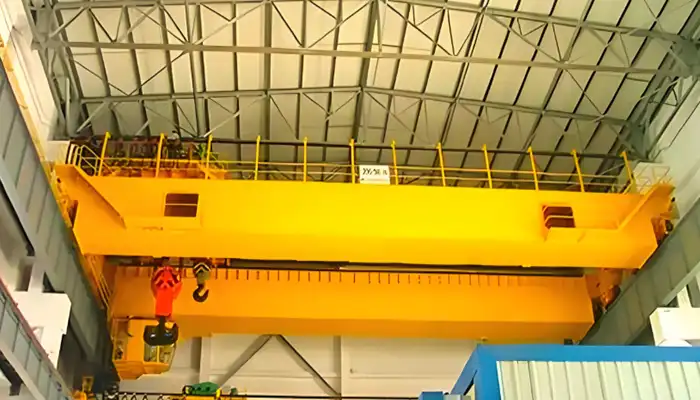
Typical Applications of QB Explosion-Proof Double Girder Cranes
QB explosion-proof cranes are built tough to handle the demands of hazardous workplaces. Their design meets strict safety standards, making them perfect for industries where flammable gases, vapors, or dust are present. These cranes keep operations smooth and safe in challenging conditions. Here are some common places where QB cranes are widely used:
- Chemical Processing Plants
These plants handle volatile chemicals that can easily ignite. QB cranes safely lift and move heavy equipment and materials without risk of sparks or explosions. - Oil and Gas Refineries
Refineries work with highly flammable gases and liquids. Explosion-proof cranes are essential here to ensure safe handling of heavy parts and products. - Wastewater Treatment Facilities
Some wastewater plants deal with combustible gases. QB cranes provide reliable lifting solutions without compromising safety. - Paint and Coating Plants
The paint industry involves flammable solvents and dust. Using explosion-proof cranes helps prevent accidents during material handling. - Gas-Fired Power Stations
Power stations using gas fuel require equipment that won’t ignite explosive atmospheres. QB cranes fit perfectly for maintenance and operational lifting tasks.
Advantages of the QB Explosion-Proof Overhead Crane
The QB explosion-proof overhead crane stands out for combining strong performance with safety. It’s designed not just to meet the toughest industry standards but also to deliver smooth and reliable operation. Here’s what makes the QB crane a smart choice for hazardous environments:
- Innovative and Durable Structural Design
Built with a robust double girder frame, the crane offers excellent strength and stability. Plus, it has a sleek, professional look that fits modern industrial facilities. - High Safety and Reliability
Every part of the crane is engineered to meet strict explosion-proof standards. This ensures safe operation even in the most dangerous settings. - Intelligent Control Systems
The crane comes with smart controls for precise handling. It runs quietly and uses energy efficiently, reducing operating costs. - Low Maintenance and Long Service Life
Designed for durability, the QB crane requires less upkeep and delivers many years of reliable service, keeping your investment safe.
Conclusion
The QB series explosion-proof overhead cranes are built to handle tough jobs safely and reliably in hazardous environments. They combine strong construction with advanced safety features to protect both people and property.
With a wide range of lifting capacities and spans, these cranes offer great flexibility. Whether you need a smaller unit for lighter tasks or a heavy-duty crane for demanding industrial work, the QB series has you covered.
Buyers looking for equipment that meets strict safety standards without compromising on performance will find the QB cranes an excellent investment. Their durability and efficiency ensure long-term value with lower maintenance costs.
In short, the QB explosion-proof cranes provide peace of mind, smooth operation, and compliance with international regulations—making them a smart choice for any facility working in explosive or hazardous zones.

